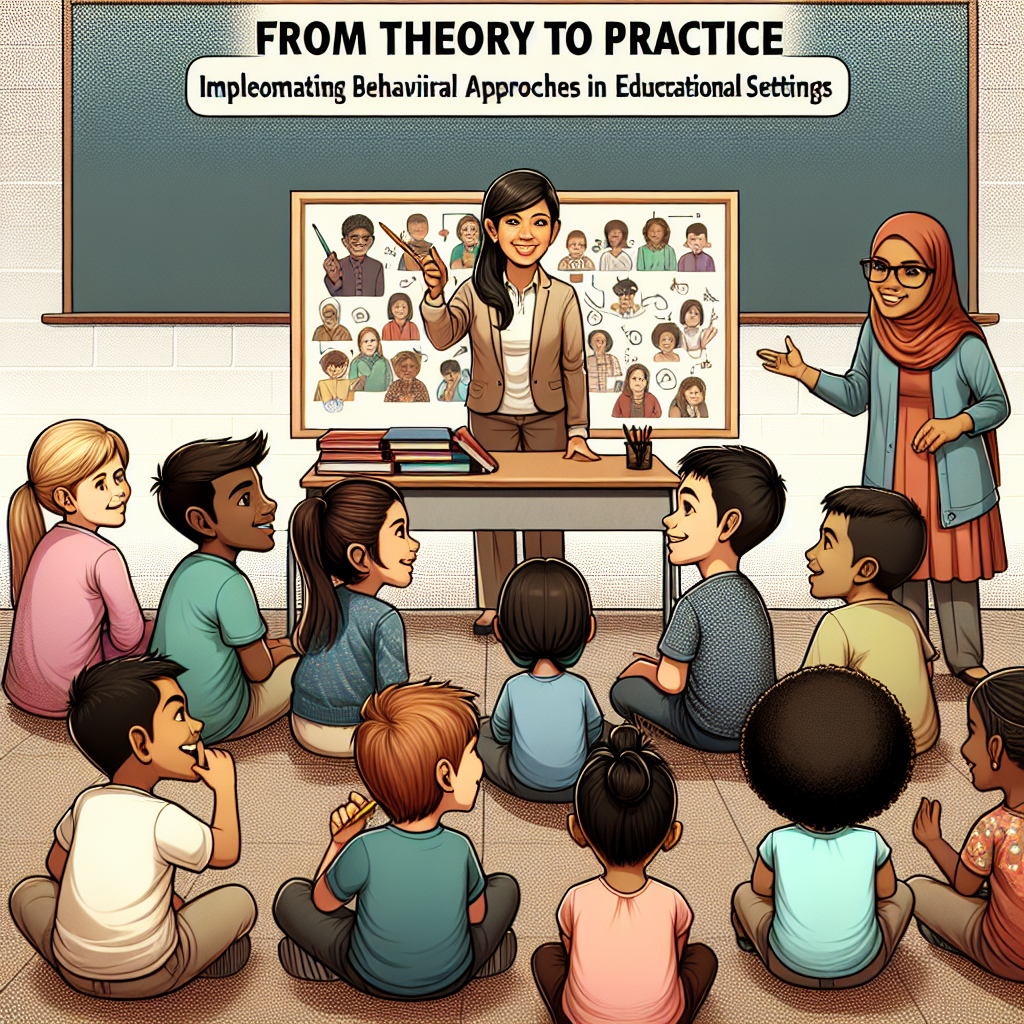From Theory to Practice: Implementing Behavioral Approaches in Educational Settings
Introduction: The Transformative Power of Behavioral Approaches
In the rapidly evolving landscape of education, traditional methods are often inadequate to meet diverse student needs. The shift towards behavioral approaches represents a pivotal opportunity to enhance learning outcomes. From Theory to Practice: Implementing Behavioral Approaches in Educational Settings is not just an academic exercise; it’s a necessary paradigm shift that can transform classrooms and increase student engagement. By understanding and applying behavioral theories, educators can create an enriched learning environment that fosters both academic success and personal growth.
Understanding Behavioral Approaches
What Are Behavioral Approaches?
Behavioral approaches to education are rooted in the principles of behaviorism, which emphasize observable behaviors as indicators of learning. Unlike cognitive theories that focus on internal processes, behavioral approaches concentrate on external stimuli and responses, allowing for measurable outcomes in educational settings.
Key Principles of Behaviorism
To implement behavioral approaches effectively, educators must grasp the following key principles:
- Reinforcement:
- Positive reinforcement strengthens desired behaviors by providing rewards.
- Negative reinforcement removes unfavorable stimuli to encourage behaviors.
- Punishment:
- While often viewed negatively, punishment can discourage undesirable behaviors when applied judiciously.
- Conditioning:
- Classical and operant conditioning techniques help shape student behavior effectively.
Table 1: Summary of Key Behavioral Principles
| Principle | Description | Example |
|---|---|---|
| Reinforcement | Strengthens behavior by providing rewards | Praise for completing homework |
| Punishment | Discourages undesirable behavior | Loss of recess time for misbehavior |
| Conditioning | Pairs stimuli to elicit a response | A bell ringing followed by lunchtime |
The Journey from Theory to Application
Step 1: Understanding Student Needs
Before implementing behavioral strategies, educators must assess the needs and dynamics of their classrooms. Conducting surveys or focus groups can provide insight into student behavior and preferences.
Step 2: Designing Behavioral Interventions
Once needs are assessed, educators can craft tailored interventions. A systematic approach might include:
- Clear Expectations: Outline behavioral expectations in a positive and clear manner.
- Consistent Reinforcement: Develop a system for rewarding good behavior consistently across class activities.
Step 3: Monitoring and Adjusting
Behavioral strategies must be dynamic. Educators should regularly monitor student responses and adjust interventions based on their effectiveness. This may involve:
- Regular feedback mechanisms.
- Adjusting reinforcements as students progress.
Real-World Applications: Case Studies
Case Study 1: The Token Economy System
Setting: A middle school in a large urban district.
Implementation: Teachers implemented a token economy system where students earned tokens for positive behaviors, which could be exchanged for privileges.
Results: An increase in positive behaviors was noted, alongside a 15% decrease in disciplinary incidents.
Analysis: This case exemplifies From Theory to Practice: Implementing Behavioral Approaches in Educational Settings, demonstrating the effectiveness of reinforcement in reshaping student behavior.
Case Study 2: Classroom Behavior Contracts
Setting: An elementary school in a suburban area.
Implementation: Teachers developed behavioral contracts with students, outlining expectations and consequences clearly.
Results: The school noted a significant reduction in classroom disruptions and an uptick in student engagement.
Analysis: The use of clear behavioral expectations rooted in contracts reflects a successful application of behavioral principles, supporting the shift from theory to practical implementation.
Table 2: Impact of Interventions on Student Behavior
| Intervention | Pre-Implementation Disruptions | Post-Implementation Disruptions |
|---|---|---|
| Token Economy System | 20/day | 5/day |
| Classroom Behavior Contracts | 30/day | 10/day |
Challenges in Implementing Behavioral Approaches
Resistance to Change
Some educators may resist moving away from traditional methods. Addressing this requires professional development focused on the benefits of behavioral approaches.
Classroom Diversity
Classrooms often comprise students with varied backgrounds and abilities. Customizing behavioral interventions to accommodate this diversity is essential for success.
The Role of Technology in Enhancing Behavioral Approaches
Data-Driven Solutions
Leveraging technology tools can streamline the process of monitoring and analyzing student behavior. For example, apps that track behavior in real time can provide immediate feedback to both students and educators.
Interactive Learning
Using gamification techniques can also enhance the effectiveness of behavioral approaches. When students engage in educational games, they often respond better to behavioral reinforcements.
Conclusion: Embracing the Future of Education
From Theory to Practice: Implementing Behavioral Approaches in Educational Settings offers a path towards a more effective, engaging, and supportive learning environment. By grounding educational practices in proven behavioral strategies, we empower students, promote positive behavior, and foster a thriving educational culture. Educators equipped with these tools are better prepared to inspire and transform the lives of their students.
FAQs
1. What are behavioral approaches in education?
Behavioral approaches emphasize observable behaviors and use reinforcement and conditioning techniques to shape student learning.
2. How can I implement behavioral strategies in my classroom?
Start by assessing student needs, designing tailored interventions, and monitoring their effectiveness over time.
3. Are there any disadvantages to behavioral approaches?
Yes, over-reliance on external rewards can lead to superficial learning, and some students may respond differently to behavioral strategies.
4. Can technology enhance the implementation of behavioral approaches?
Absolutely! Technology can provide valuable data for monitoring behavior and increase engagement through interactive learning experiences.
5. How do I handle diverse student needs when implementing behavioral approaches?
Customize strategies to accommodate individual differences in learning styles, backgrounds, and capabilities to achieve a more inclusive approach.
By adopting a focused, systematic approach to implementing behavioral strategies, educators can bridge the gap between theory and practice, paving the way for a brighter, more effective educational future.

